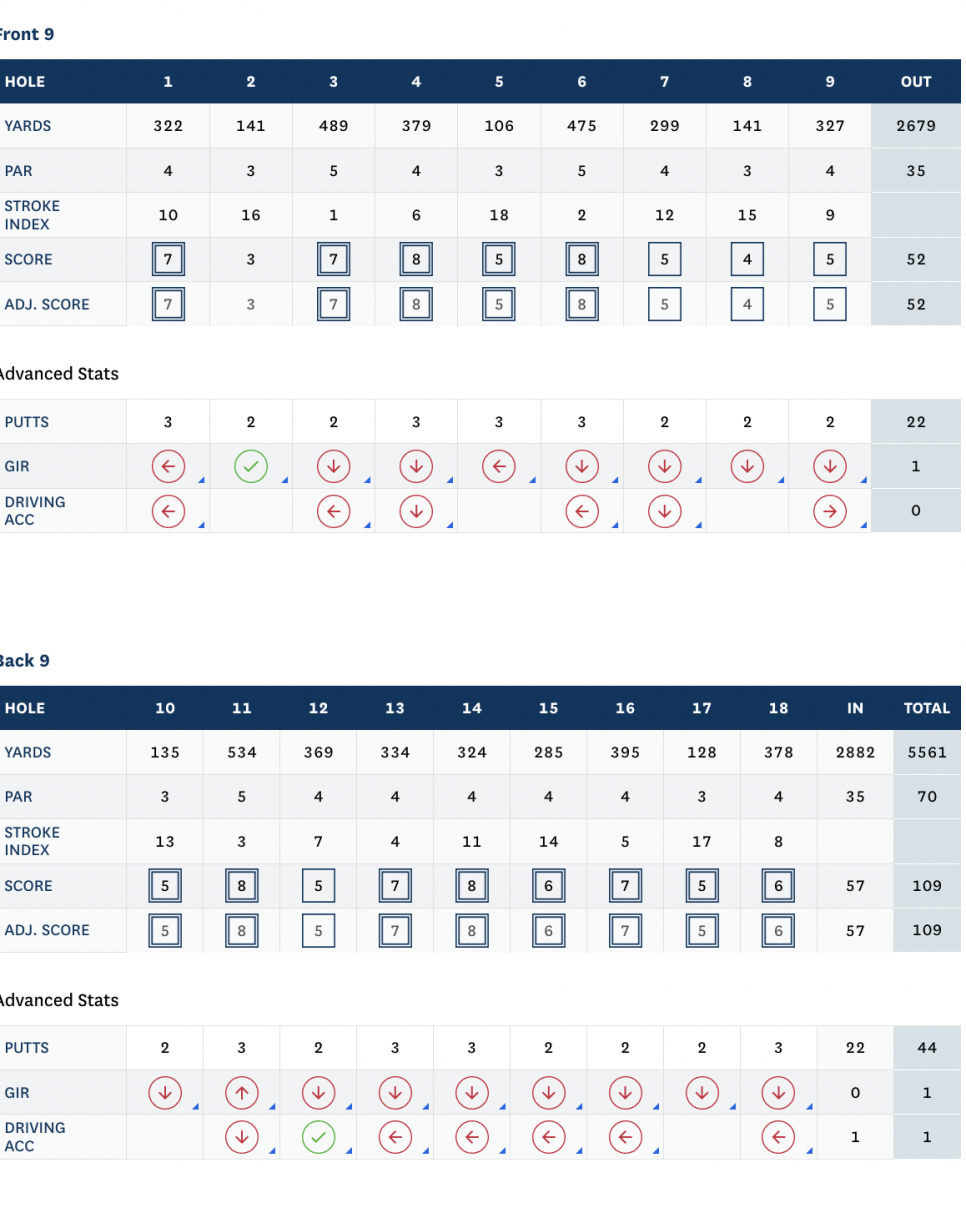We’ve been looking at our stats all wrong – Australian Golf Digest

- by Admin
- May 24, 2024

This is a free version of Low Net, a weekly newsletter written for the average golfer, by an average golfer. To get Low Net each week, sign up for Golf Digest+. Have a topic you want me to explore? Send me an email and I’ll do my best to dive in.
One thing about mid-handicap golfers is we don’t fit into any single box. There are the ones who hammer drives but blade every wedge; the kind who make everything for 5; plus, those easily derailed by nerves, lapses in concentration, or generous halfway house pours.
There is no shame in having a thing that holds you back. Everyone in golf has at least one. The shame is in not paying close enough attention to do anything about it.
As part of a season-long project in which three colleagues and I are tracking the progress of our games and our Handicap Index, a worthwhile question is how to interpret the assorted numbers we can track in a round of golf. In the GHIN app, I habitually enter my hole-by-hole scores, fairways and greens in regulation, and putts per round, very often before I even remove my golf shoes. But the goal is not to just use numbers to tell me how I play. But how I can use those numbers to play better.
“Stats are great, but they’re like just telling you that you have a fever,” said Kyle Morris, owner and director of instruction for The Golf Room. “On their own, they don’t do anything to eliminate the fever.”
In 2021, Kyle wrote a story for Golf Digest about what golf KPIs, or Key Performance Indicators, are worth tracking for players of different levels. When it came to this season’s project, he was a natural coach to consult on where and how we should be channeling our energy.
1. Beginners: cut down on the clunkers
For starters, I told Morris about my colleague Greg Gottfried, who is taking part in our season-long project as a beginner, and who just recently posted his first two scores to GHIN. The scorecards weren’t pretty—plenty of doubles or worse adding up to rounds over 100. That Greg was hitting one fairway and one green in regulation a round marked one area for improvement, but Kyle wanted to drill down deeper.
“How many errors do you have?” Morris asked. “Errors meaning like shots where you would go, ‘How did that just happen?’ “Like, ‘Oh, I topped it off a tee box.’ Or, ‘Oh, I chunked an iron.”
For true beginners, the first way to trim fat off scores is to eliminate the shots that fail to truly advance the ball. Morris calls them errors, or “clunkers,” and often speak to poor contact that can be addressed through improved grip and alignment. According to the golf stats pioneer, Mark Brodie, golfers who fail to break 100 hit at least six of these shots a round. When I checked with Greg if that was his experience, he offered little more than a pained smile.
2. Want to break 80? Doubles are death
I have been an 11 Handicap Index for what feels like a decade, and yet based on ball-striking alone, my game seems poised for a breakthrough. So why am I still stuck in the mid-80s? The answer, Morris said, is all there in my stats. According to GHIN, 19 percent of my holes are still double bogeys or worse, way too high a figure for someone who aspires to a single-digit index.

“The number one stat that separates amateurs from pros is the amount of doubles,” he said. “The biggest difference between Xander Schauffele and you is not the amount of birdies he is making, but the number of double bogeys he is not making.”
RELATED: The key stat for breaking 80
Given all the work I’ve put into my game the last year, one would think the biggest mistakes would melt off my card. Instead, I’ve recognized a new dynamic in which greater confidence has led to dumber decisions–taking on flagsticks I should avoid, or trying to hole putts rather than simply lagging them close. In retrospect, Morris said, I need less exciting, and “more boring.”
More Low Net  Low Net The best case for golf yet
Low Net The best case for golf yet  Golf Digest Logo This is why you clam up when other golfers are watching
Golf Digest Logo This is why you clam up when other golfers are watching  Golf Digest Logo How to be a less miserable golfer Don’t be a “day-trader”: Focus on the macrotrends
Golf Digest Logo How to be a less miserable golfer Don’t be a “day-trader”: Focus on the macrotrends
Especially for those of us who don’t play golf for a living, our stats should be clues to where we need to spend our time. Morris uses another business acronym—ROI, or return on investment. “You have to have a clear-cut plan as to what you’re going to do to have the maximum ROI for the time that you have,” he said.
The potential problem here is not taking the full scope of your game into account. Very often golfers will overreact to a round they just played and adjust their plan to that. Of course, recent feedback can be valuable, but you need to be leery of it not distorting the broader picture. Suppose you’re working on a specific feel in your driver swing that is generally helping but you hit only three fairways tee last Sunday. That doesn’t mean you should wipe the slate clean.
“I think that amateur golfers are too nearsighted in that they’re just looking at their last round’s stats,” Morris said. “They’re basically looking at it like their day traders, and when you do that, it’s really hard to notice any patterns.”
This article was originally published on golfdigest.com
The Latest News
-
December 23, 2024‘I felt horrible’: How Brett Lee went from an ill-fated threat to Test stardom in four balls
-
December 23, 2024China and India Are the Biggest Tourism Market for Victoria As This Australian City Attracts International Tourists with Sports Tourism – Travel And Tour World
-
December 23, 2024Christmas comes early for several Aussies after last-minute dash for tour status – Australian Golf Digest
-
December 23, 2024Shami ruled out of Test return in Australia | cricket.com.au
-
December 23, 2024Live: ASX to poised to open lower despite a rally on Wall Street





